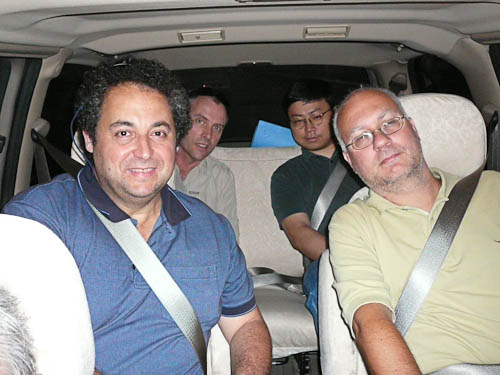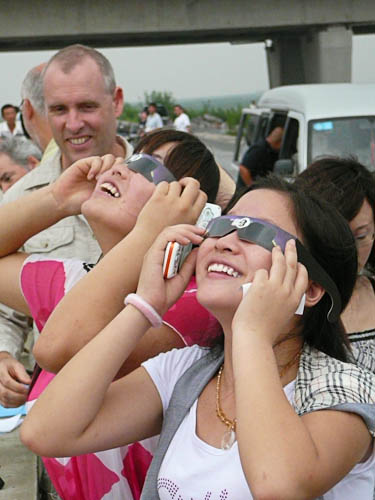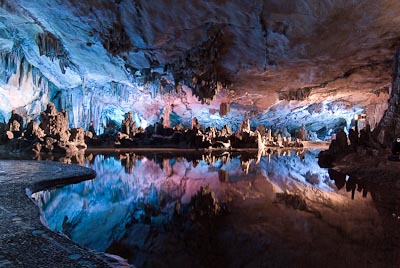
 |
WAITING FOR THE
SHADOW
SOLAR AND LUNAR ECLIPSE OBSERVINGREPORTS AND OBSERVATIONS |
|
|
|
|
|
|
|
|
|
|
Bengt Alfredsson
|
Joe Cali
|
|
Ryo Kato
|
Dan Orange
|














| Photo above left : The picture above is my home made lightweight equatorial. The tripod, single arm fork EQ head and controller weigh 4.5kg. The dominant design parameter was minimization of weight therefore counterweights needed to be eliminated. The polar face of the fork arm has milled slots on the attachment bolts to the polar flange so that I can slide it transverse to the polar axis to allow for payload balancing without the need for any counterweights. Once set for a payload it can be left in that position until the OTA configuration is changed. I make a fixed angle wedge out of wood before each eclipse. This is much lighter if less convenient than having a variable adjustment polar angle setting. I can also make up to 5 degrees of adjustments to angles using the legs which tilt independently to allow for a change of observing location. The OTA is a William Optics 70mm f6.2 APO. I've fitted it with a flip mirror box to switch the optical path between an eyepiece and DSLR camera. I chose this eyepiece for eclipse work and will continue to use it. It is a University Optics Konig 16mm that gives me a 2.4 degree field of view with 26x magnification. I custom machined a parfocalizer tube for that particular eyepiece so that camera and eyepiece are precisely parfocalized. This mounting has been under development since the 2001 TSE in Africa. I am basically pretty happy with it now. My checked luggage weight this year was 20.7kg and my hand luggage was within normal limits. I will eventually write a more detailed and better illustrated article about the mount. |
Photo above right: Ryo Kato's Skywatcher EQ3 mount carrying a William Optics 70mm f6.2 APO. Ths is an off the shelf model. Ryo has managed to find a way to transport this solid little mounting on aircraft. Ryo made sure he used an airline that had a 30kg luggage allowance so that he could transport the scope. His mounting is much more rigid than mine and far less prone to vibration. If the wind blows hard, I am in trouble, he might be OK. I am gambling on the fact that even if strong wind was present before an eclipse, it usually dies out before totality. During our discussions about telescopes and mountings Ryo did say that it was a bit too heavy to fly around with and he needed to find ways to cut down the weight. Greg and I had on nuerous occasions discussed the modification of this type of mount. Greg suggested he replace the extendable steel legs with short single section aluminium legs as a first step. Then removing the dec axis and replacing it with something similar to mine that eliminated the heavy dec axis, housing, motor and counterweights. |

 |
The
lightweight tracker arm Behind the two tripod mounted Canon cameras, Bengt Alfredsson was using a Nikon 180f2.8 with a 300D body. Camera was mounted on a prototype tracking arm built by Joe Cali. It was completed only one day before departure Had we seen the eclipse, it would have worked well enough to image but some design problems were identified in this field test. We hope to have it working better for future eclipses. The tracker is an equatorial 'syngent' drive arm, similar to a tangent drive but the mathematical function of the error curve for this mechanical design is sinusoidal not tangential. The tracker arm itself with controller weighs in at 1.5kg (tripod not included). I hope to reduce this to 1.2kg. It will easily hold my William Optic 70mm f6.2 OTA with mirror flip box, eyepiece and DSLR camera(3.5kg payload). It easily holds Bengt's Nikon 300D with 180mmf2.8 lens. I think it would probably hold any short OTA up to a 4" cass or Maksutov or refractors up to 80mm diameter and up to 400-500mm focal length. Longer OTA's will put too much strain on the tripod head holding it. For smaller camera/lens combinations, you could use a ball and socket smaller & lighter than the Manfrotto 141 head we used. Its design was based on the question, "What is the minimum tracking precision required to accurately photograph a solar eclipse with a small telescope or lens?" The answer is a range of solutions to a compicated multi-variable problem but basically for most small fast optical systems, the drive only has to keep the image roughly centred for about two hours and be accurate enough to allow an unguided exposure at mid-eclipse of between 1/2s - 8s depending on the optics used. The radius arm on the tracker has plenty of torque for heavy radial loads but without the bulk of a full worm drive. A complete description will appear on this site when the tracker is completed. We plan to make two more, one for me and one for a friend who is an expert engineer/machinist who is also involved with the design and construction. I didn't get a close up of the tracker at the eclipse site but here is a photo taken at the apartment. |

It's always interesting to contrast the way different people utilize similar equipment. I found this picture of Joel Moskowitz on Glenn Schneider's site. Joel (in Wuhan not at our site) was using some of the same basic mounting gear as Greg Bond but in an entirely different way. Joel has used the same Manfrotto carbon fibre 055c tripod and geared head. But unlike Greg who used the geared head as his eq head, Joel is using the geared head as an equatorial wedge. Joel then has an Astrotrac TT to track the Sun and a very substantial ball head to rigidly support the heavy payload. Joel was using a Sky 90 FL=500mm and needed motorized tracking while Greg was using a 200mm telephoto and he was willing to manually track using the Manfrotto gear head. Each had different travel objectives. Greg, Bengt and I went traveling post eclipse. I haven't checked but Joel was probably only there for the eclipse. Just comparing mounting components alone, Joel's photo mounting equipment probably weighed 2kg more than Greg's. For new eclipse chasers reading this passage, it is a very good lesson in bringing just what you need. With longer focal lengths, Joel needed better tracking and has a setup to match. Using a 200mm lens, Greg didn't need the tracking so he didn't weigh himself down with unnecessary gear. Optimize your equipment to the required task. The tracking arm I built for Bengt weighs exactly the same as the Astrotrac (1.4kg). But my arm uses a strong lightweight wooden wedge to set the equatorial angle, I make them from wood before each eclipse at the correct angle for the observing location. Even if I have to move to avoid cloud it is rarely going to be more than a couple of degrees of latitude and it has enough adjustment for that. Joel could basically save almost the entire weight of the geared head from his kit by using a lightweight wedge. Of course this might not be important to him but it might be to someone else wanting to put a similar kit together and save some weight. The tracking of my arm isn't perfect but it's good enough for exposures up to 8s - all that's required for a solar eclipse and can be made from components costing 1/10th the price of the Astrotrac. USD1400 is a lot to spend on something that you only use for a couple of minutes every couple of years. Different if you want to use it for other applications. There are other ways to save weight. Note the multigrips and leatherman tool that Joel uses. These two tools probably weigh 500 grams. For the telescope mount I've designed, the only tools required for field assembly are a small 100mm shift spanner and a 3mm and a 5mm allen key. In addition, I carry one small jewellers screwdriver and 1.5mm and 2mm allen keys to make fine adjustments to the drive system but these weigh almost nothing. The tracker arm has been similarly designed but we did need a 150mm shift spanner this year to do up one bolt on the tracker arm. Before it is next used, I will either mill a lightweight wrench out of thin steel or else braze side pins into the nut so that it can be tightened by hand. |
 |
















